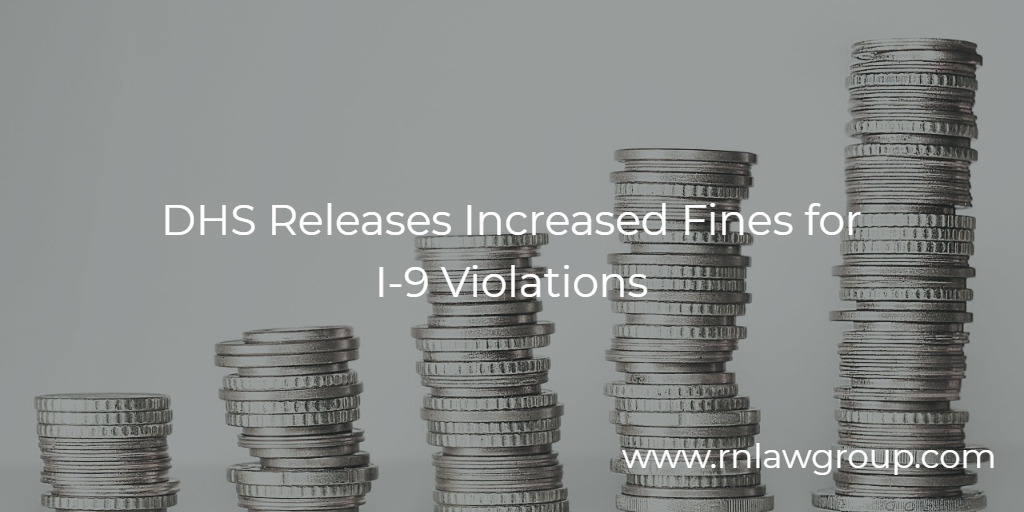
DHS Releases Increased Fines for I-9 Violations
The Department of Homeland Security (DHS) has released new increased fines for Form I-9 civil penalties to account for annual inflation. The new fines will be effective for penalties assessed after October 18, 2021 for associated violations that occurred after November 02, 2015. The increased fines are as follows:
Substantive/Uncorrected Technical Paperwork Violations:
- Minimum fine per violation for substantive paperwork or uncorrected technical violations increased from $234 to $237
- Maximum fine per violation for substantive paperwork or uncorrected technical violations increased from $2,332 to $2,360
Knowingly Hiring/Continuing to Employ Unauthorized Workers:
- First offense fines increased from to $583-$4,667 to $590-$4,722
- Second offense fines increased from $4,667-$11,665 to $4,722-$11,803
- Third or subsequent offense fines increased from $6,999-$23,331 to 7,082-23,607
Employers must verify the identity and employment authorization of all hired workers by completing Form I-9 and re-verify work authorization when required. Mistakes on this seemingly simple 2-page Form I-9 can add up fast and lead to heavy civil fines in the event an employer is issued a Notice of Inspection by Immigration and Customs Enforcement (ICE). A Notice of Inspection is basically an audit of a company’s I-9 files.
If an employer is issued a Notice of Inspection, ICE will provide the employer only 3 days to produce its I-9 forms for each employee along with payroll records and other corporate documents. After ICE conducts a review of the I-9 forms, the employer will be issued a “Notice of Technical or Procedural Failures” letter for all technical violations identified during the I-9 inspection. The employer will be given 10 business days to correct any technical errors identified by ICE. If the employer does not make the corrections as instructed by ICE, those uncorrected technical violations will be treated and fined as substantive violations. Note that unlike technical violations, actual substantive errors are not allowed to be corrected. Fines will then be assessed accordingly for substantive violations and uncorrected technical violations through a Notice of Intent to Fine. For a detailed look at how ICE assigns fines, please visit our related article: Employers Should Strongly Consider Conducting Regular I-9 Internal Audits.
A few examples of substantive and technical paperwork violations include:
Substantive Paperwork Violations:
- Failure to timely prepare Form I-9
- Failure to re-verify employment authorization in a timely manner in Section 3 when applicable
- Failure by the employer to sign the attestation in Section 2 of Form I-9
- Failure by the employer to sign the attestation in Section 3 when re-verification is required
- Completing a false Section 2 attestation such as when the certifier examines the documents outside the presence of the employee presenting them
- Failure by the employee to sign Section 1
- Failure to timely present Form I-9
- Failure to prepare Form I-9 for an employee
- Failure to correct technical errors within the allotted window after being served a Notice of Technical or Procedural Failures letter by ICE
Technical Paperwork Violations:
- Failure by the employee to list his or her maiden name, address, or birth date in Section 1
- Failure by the employee to include his or her “A” number if the box is checked in Section 1 indicating he or she is a permanent resident (will only be considered technical if the A number is included in Section 2 or on a copy of a document retained with the I-9, otherwise will be considered substantive)
- Failure by the employee to include his or her “A” number or admission number if the box is checked in Section 1 indicating that he or she is “an alien authorized to work” in the United States (will only be considered technical if the number is included in Section 2 or on a copy of a document retained with the I-9, otherwise will be considered substantive)
- Failure of the form’s preparer or translator to print his or her name, address, signature or date in the preparer’s certification box
- Failure by the employer to provide the title, business name, and business address in Section 2
Prioritizing a comprehensive internal review of your company’s I-9 files is essential to ensure full compliance with I-9 rules and procedures in order to avoid civil fines for I-9 violations. At Reddy & Neumann, our team provides employers with a variety of services related to I-9 compliance, including:
- A complete review or sampling of a company’s I-9 documents for technical, procedural and substantive errors;
- Guidance on lawfully correcting errors on Form I-9;
- An evaluation of the company’s I-9 and E-Verify profile including the company’s hiring processes and procedures;
- An evaluation of HR training requirements pertaining to I-9 and E-Verify compliance;
- An evaluation on the company’s record retention and storage policy to ensure compliance with federal requirements;
- Advice regarding the pros and cons of enrollment in E-Verify; and
- Representation in the event of a Notice of Inspection issued by ICE.
By: Krystal Alanis
Krystal Alanis is a Partner at Reddy Neumann Brown PC, Houston’s largest immigration law firm focused solely on U.S. employment-based immigration. She acts as the Managing Attorney for the firm’s PERM Labor Certification Department, where she oversees all EB-2 and EB-3 employment-based green card matters. She also guides employers and individuals through the I-140 and Adjustment of Status process, assists clients with non-immigrant visa petitions (e.g. H-1B, TN, L-1, etc.), and advises her clients on I-9 compliance issues.

